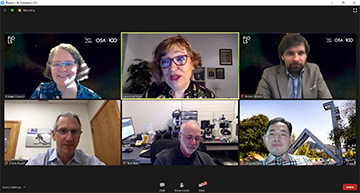![]()
Getty Images
Since the worldwide COVID-19 pandemic began, biophotonics researchers have ramped up their efforts to enlist their cutting-edge technologies against the disease and the virus that causes it. Two special sessions at the FiO+LS 2020 conference addressed this area of concern head-on.
Silicon photonics and fluorescence
In a discussion on Wednesday, 16 September, panelists talked about teams of optical scientists on three continents that are addressing one of the major bottlenecks of the pandemic: the need for rapid and accurate testing of COVID-19 patients and potential patients.
Panelist and OSA Fellow Laura Lechuga and her colleagues at Spain’s Catalan Institute of Nanoscience and Nanotechnology have received European Union funding to develop a point-of-care nanophotonic biosensor that would detect the presence of the coronavirus that causes COVID-19, officially known as SARS-CoV-2.
As outlined in an OPN cover story in April, Lechuga’s group has been designing silicon photonics devices with up to 20 biosensors on a chip. When light travels down a waveguide within the chip and interacts with a virus or its antibodies, it undergoes a phase change, which can be analyzed when the light exits the chip. In a point-of-care system, such a device would not only answer the “yes/no” question of whether a person is infected with a specific virus, but also quantify the viral load.
According to Lechuga, the Catalan group is pursuing three lines of chip-detector research. One would employ complementary DNA probes to sequence the RNA of the coronavirus. The second would directly capture and detect the intact viruses in a one-step assay, providing results in 20 minutes or less. The third would detect SARS-CoV-2 antibodies in patients with only mild symptoms, or who are completely asymptomatic.
Preliminary virus-detection results from experiments with a nonpathogenic virus are promising. In ongoing tests of serum samples from COVID-19 patients, Lechuga and her colleagues found that their devices could detect the presence of antibodies down to the levels of 0.01 μg/mL to 0.05 μg/mL. (These patients typically present with levels in the 10–100 μg/mL range.)
Adapting optical technology

Clockwise from top left: moderator Kristan Corwin, NIST, USA; Laura Lechuga, Catalan Institute of Nanoscience and Nanotechnology, Spain; Krister Shalm, NIST, USA; Jong Mo Seo, Seoul National University, Republic of Korea; Thomas Baer, Stanford University, USA; and Chris Myatt, MBio Diagnostics, Inc., USA.
Another effort discussed during the special session was U.S.-based company MBio Diagnostics’ endeavor to adapt its portable fluorescence analyzer to the COVID-19 crisis. Panelist and company founder Chris Myatt says that the system uses disposable plastic cartridges, each furnished with a microarray of reagents on a substrate. When the reagents contact the biological material of interest, their fluorescence is captured by the analyzer’s camera. Myatt says the device generates results in five minutes or less.
Just that morning, Myatt said on Wednesday, the U.S. Food and Drug Administration had given MBio permission to market its COVID-19 antibody test. Full FDA approval has yet to come, but the company is seeking an emergency-use authorization, which bypasses the usual lengthy approval process in urgent situations such as the pandemic. MBio is also collaborating with the U.S. Department of Defense healthcare system on quantitative measurements of “cytokine storm” reactions in severely ill COVID-19 patients.
Jong Mo Seo, an ophthalmologist and biomedical engineer at Seoul National University in the Republic of Korea who also participated in the panel discussion, cautioned against “mixed hypes and hopes” surrounding the various diagnostic technologies. The results from COVID-19 detectors need to be weighed against similar diagnostics for other infectious respiratory diseases, such as pneumonia and influenza, he says.
Tracking and tracing
Although the big U.S. technology companies have invested much time and effort in developing automated contact-tracing systems, Krister Shalm, a scientist at the U.S. National Institute of Standards and Technology (NIST) who rounded out the panel, worries that such programs will exclude vulnerable communities: prisoners, nursing-home residents, meatpacking-plant workers and people too poor to afford smartphones. As of July, 40% of all COVID-19 deaths in the U.S. were connected to nursing homes, which account for just 1% of the nation’s population.
To reach people who aren’t tied in to technological and social networks, Shalm and his NIST colleagues are testing small, Bluetooth-enabled “dongles” that could be customized to the needs of a specific community. Each device would cost US$20 or less, run on an open-source platform, and would record the number of times the wearer passed within a certain distance from another wearer.
According to Shalm, the accumulated data from such dongles—“encounter metrics”—could even lead to new designs for the interior spaces of office buildings and healthcare facilities, to make them more resistant to the spread of future pandemics.
Modeling the spread of COVID-19 within a given population actually has mathematical similarities to the dynamics of atoms in a laser cavity, Shalm noted.
Updating earlier efforts

Thomas Baer, Stanford University, USA.
OSA Fellow and 2009 OSA President Thomas Baer of Stanford University, USA, has been working with his daughter, Christina Baer of the University of Massachusetts Medical School, USA, on COVID-19 detection and disinfection strategies. During his session on Wednesday, 16, September, Thomas Baer gave the FiO+LS audience an update on the optics community's response to the pandemic.
Since the Baers wrote their OPN article and presented an OSA webinar back in May, scientists have realized that a much larger proportion of COVID-19 patients are asymptomatic than previously thought, so that “active surveillance” with frequent, regular screenings for the virus will be crucial to containing the disease. According to Tom Baer, simple tests such as the National Basketball Association’s saliva test, which eliminates several of the purification steps of regular polymerase chain reaction (PCR) tests, or a colorimetric test developed by Columbia University, USA, could make mass screenings feasible.
